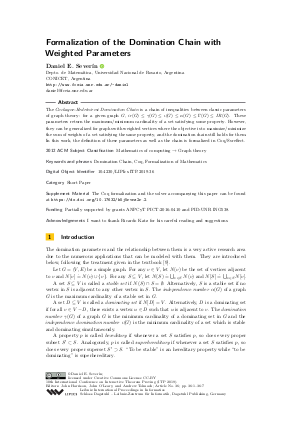Formalization of the Domination Chain with Weighted Parameters (Short Paper)
Author
Daniel E. Severín 
-
Part of:
Volume:
10th International Conference on Interactive Theorem Proving (ITP 2019)
Part of: Series: Leibniz International Proceedings in Informatics (LIPIcs)
Part of: Conference: International Conference on Interactive Theorem Proving (ITP) - License:
 Creative Commons Attribution 3.0 Unported license
Creative Commons Attribution 3.0 Unported license
- Publication Date: 2019-09-05
File

PDF
LIPIcs.ITP.2019.36.pdf
- Filesize: 394 kB
- 7 pages
Document Identifiers
Subject Classification
ACM Subject Classification
- Mathematics of computing → Graph theory
Keywords
- Domination Chain
- Coq
- Formalization of Mathematics
Metrics
- Access Statistics
-
Total Accesses (updated on a weekly basis)
0Document
0Metadata
Abstract
The Cockayne-Hedetniemi Domination Chain is a chain of inequalities between classic parameters of graph theory: for a given graph G, ir(G) <= gamma(G) <= iota(G) <= alpha(G) <= Gamma(G) <= IR(G). These parameters return the maximum/minimum cardinality of a set satisfying some property. However, they can be generalized for graphs with weighted vertices where the objective is to maximize/minimize the sum of weights of a set satisfying the same property, and the domination chain still holds for them. In this work, the definition of these parameters as well as the chain is formalized in Coq/Ssreflect.
Cite As Get BibTex
Daniel E. Severín. Formalization of the Domination Chain with Weighted Parameters (Short Paper). In 10th International Conference on Interactive Theorem Proving (ITP 2019). Leibniz International Proceedings in Informatics (LIPIcs), Volume 141, pp. 36:1-36:7, Schloss Dagstuhl – Leibniz-Zentrum für Informatik (2019)
https://doi.org/10.4230/LIPIcs.ITP.2019.36
BibTex
@InProceedings{severin:LIPIcs.ITP.2019.36,
author = {Sever{\'\i}n, Daniel E.},
title = {{Formalization of the Domination Chain with Weighted Parameters}},
booktitle = {10th International Conference on Interactive Theorem Proving (ITP 2019)},
pages = {36:1--36:7},
series = {Leibniz International Proceedings in Informatics (LIPIcs)},
ISBN = {978-3-95977-122-1},
ISSN = {1868-8969},
year = {2019},
volume = {141},
editor = {Harrison, John and O'Leary, John and Tolmach, Andrew},
publisher = {Schloss Dagstuhl -- Leibniz-Zentrum f{\"u}r Informatik},
address = {Dagstuhl, Germany},
URL = {https://drops.dagstuhl.de/entities/document/10.4230/LIPIcs.ITP.2019.36},
URN = {urn:nbn:de:0030-drops-110919},
doi = {10.4230/LIPIcs.ITP.2019.36},
annote = {Keywords: Domination Chain, Coq, Formalization of Mathematics}
}
Author Details
Funding
Partially supported by grants ANPCyT PICT-2016-0410 and PID-UNR ING538.
Acknowledgements
I want to thank Ricardo Katz for his careful reading and suggestions.
Supplementary Materials
- The Coq formalization and the solver accompanying this paper can be found at https://dx.doi.org/10.17632/h5j5rvrz2r.2.
References
- X. Allamigeon and R. Katz. A Formalization of Convex Polyhedra Based on the Simplex Method. J. Autom. Reasoning, pages 1-23, 2018. URL: https://doi.org/10.1007/s10817-018-9477-1.
- C. Bazgan, L. Brankovic, K. Casel, H. Fernau, K. Jansen, K.-M. Klein, M. Lampis, M. Liedloff, J. Monnot, and V. Th. Paschos. The many facets of upper domination. Theor. Comput. Sci., 717:2-25, 2018. URL: https://doi.org/10.1016/j.tcs.2017.05.042.
- A. Boyaci and J. Monnot. Weighted upper domination number. Electron. Notes Discrete Math., 62:171-176, 2017. URL: https://doi.org/10.1016/j.endm.2017.10.030.
- P. P. Davidson, C. Blum, and J. Lozano. The weighted independent domination problem: Integer linear programming models and metaheuristic approaches. Eur. J. Oper. Res., 265:860-871, 2018. URL: https://doi.org/10.1016/j.ejor.2017.08.044.
- C. Doczkal, G. Combette, and D. Pous. A Formal Proof of the Minor-Exclusion Property for Treewidth-Two Graphs. Lect. Notes Comput. Sc., 10895:178-195, 2018. URL: https://doi.org/10.1007/978-3-319-94821-8_11.
- O. Favaron, T. Haynes, S. Hedetniemi, M. Henning, and D. Knisley. Total irredundance in graphs. Discrete Math., 256:115-127, 2002. URL: https://doi.org/10.1016/S0012-365X(00)00459-3.
- G. Gonthier. Formal proof - the Four-Color Theorem. Notices Amer. Math. Soc., 55:1382-1393, 2008. URL: http://www.ams.org/notices/200811/tx081101382p.pdf.
- G. Gonthier and A. Mahboubi. An introduction to small scale reflection in Coq. J. Form. Reason., 3:95-152, 2010. URL: https://doi.org/10.6092/issn.1972-5787/1979.
-
T. Haynes, S. Hedetniemi, and P. Slater. Fundamentals of Domination in Graphs. Marcel Dekker, Inc., 1998.

- M. Jacobson and K. Peters. Chordal graphs and upper irredundance, upper domination and independence. Discrete Math., 86:59-69, 1990. URL: https://doi.org/10.1016/0012-365X(90)90349-M.
- L. Noschinski. Proof Pearl: A Probabilistic Proof for the Girth-Chromatic Number Theorem. Lect. Notes Comput. Sc., 7406:393-404, 2012. URL: https://doi.org/10.1007/978-3-642-32347-8_27.
-
D. Severín and G. Nasini. The Maximum Weighted Upper Irredundance Problem (in Spanish). In Communications of the Unión Matemática Argentina. UNLP, La Plata, September 2018.

- The Mathematical Components team. Mathematical components, 2018. URL: http://math-comp.github.io/math-comp/.
